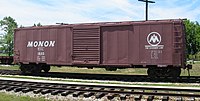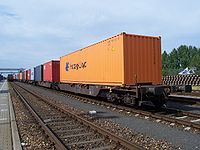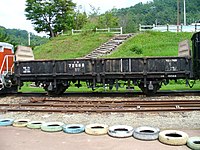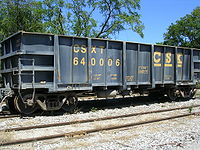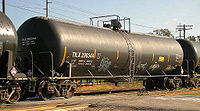AY Honors/Model Railroad/Answer Key
1. Give the history and development of model railroading.
2. Tell the difference in how the following prototype motive power units operate:
a. Steam
b. Diesel
c. Electric
3. Know the name, scale, and track gauge for four model railroad gauges.
The six most popular scales used are: G scale, Gauge 1, O scale, H0 scale (in Britain, the similarly sized 00 is used), TT scale, and N scale (1:160), although there is growing interest in Z scale. H0 scale is the single most popular scale of model railroad. Popular narrow-gauge scales include HOn3 Scale and Nn3, which are the same scale as HO and N, except with a narrower spacing between the tracks (in these examples, a scale three feet instead of the 4'8.5" standard gauge).
The words scale and gauge seem at first to be used interchangeably in model railways, but their meanings are different. Scale is the model's measurement as a proportion to the original, while gauge is the measurement between the two running rails of the track.
| Name | Scale | Gauge |
|---|---|---|
| G scale | 1:22.5 | 45 mm |
| Gauge 1 | 1:32 | 44.45 mm |
| 0 scale | 1:43 or 1:48 | 32 mm |
| H0 scale | 1:87 | 16.5 mm |
| TT scale | 1:120 | 12 mm |
| N scale | 1:148 to 1:160 | 9 mm |
| Z scale | 1:220 | 6.5 mm |
4. Know the shapes and names of at least eight track plan arrangements.
1. Oval
The simplest layout for a model railroad and the starting point for most designs. In this design, two straightaway segments are connected by a semi-circle at each end. This is also the only layout which can easily be created with sectional track without the use of a manufacturer-specific design. Curved sectional track is sold by radii (half the distance across the semi-circle) and a box of such track sections will almost always create exactly half a circle. The two straightaway sections will usually utilize multiple pieces of sectional straight track, as desired by the modeler.
2. Figure-Eight
The second most common beginner's layout. If this arrangement is desired by a beginner, either purchase it as a single set, or use sectional track as specified by a particular manufacturer's layout design (either from a book or magazine) so that the straight pieces exit the end loops at the correct angle to intersect at an angle for which a crossover piece is available. While it is possible to construct a crossover piece from scratch, this is beyond the skill level of this Pathfinder Honor.
3. Twice-Around
A modification of the figure-eight, in which one end-loop is contained within the other. Notice that the two paths are not likely to cross at 90° as in the basic figure-eight (above).
5. Know at least six points to check for the maintenance of a model railroading layout.
6. Identify and explain the use of:
a. Five types of freight cars
Covered Hopper
[Image:6619.JPG|thumb|200px|Covered hopper]] Structurally, a covered hopper is very similar to an opentop hopper car. What distinguishes this type of car from an open hopper is the car's roof, and also the car's overall size. Covered hoppers typically carry loads of less dense, and therefore lighter, materials, so they are built to a higher cubic capacity than open top hoppers.
Box Car
A boxcar (the American term; the British call this kind of car a "goods van" while in Australia, they are usually referred to as "louvre vans") is a railroad car that is enclosed and generally used to carry general freight. The boxcar, while not the simplest freight car design, is probably the most versatile, since it can carry most loads. Boxcars have side doors of varying size and operation, and some include end doors and adjustable bulkheads to load very large items.
Container Car
Containerization is a system of intermodal freight transport cargo transport using standard ISO containers known as shipping containers that can be loaded and sealed intact onto container ships, railroad cars, planes, and trucks. The introduction of containers resulted in vast improvements in port handling efficiency, thus lowering costs and helping lower freight charges and, in turn, boosting trade flows. Almost every manufactured product humans consume spends some time in a container.
Flat car
A flatcar (also flat car) is a piece of railroad rolling stock that consists of an open, flat deck on four or six wheels or a pair of trucks (US) or bogies (UK). The deck of the car can be wood or steel, and the sides of the deck can include pockets for stakes or tie-down points to secure loads. Flatcars designed for carrying machinery have sliding chain assemblies recessed in the deck. Flatcars are used for loads that are too large or cumbersome to load in enclosed cars such as boxcars. They are also often used to transport containers or trailers in intermodal shipping.
Gondola
A gondola is an open-top type of rolling stock that is used for carrying loose bulk materials. Because of its low side walls, gondolas are used to carry either very dense material, such as steel plates or coils, or bulky items such as prefabricated pieces of rail track.
Refrigerator Car
A refrigerator car (or "reefer") is a refrigerated boxcar, a piece of railroad rolling stock designed to carry perishable freight at specific temperatures. Refrigerator cars differ from simple insulated boxcars and ventilated boxcars (commonly used for transporting fruit), neither of which are fitted with cooling apparatus. Reefers can be ice-cooled, come equipped with any one of a variety of mechanical refrigeration systems, or util
Stock Car
In railroad terminology, a stock car is a type of rolling stock used for carrying livestock (not carcasses) to market. A traditional stock car resembles a boxcar with slats missing in the car's side (and sometimes end) for the purpose of providing ventilation; stock cars can be single-level for large animals such as cattle or horses, or they can have two or three levels for smaller animals such as sheep, pigs, and poultry.
Tank Car
A tank car is a type of railroad rolling stock designed to transport liquid and gaseous commodities. Outside of North America, they are also known as tank wagons or tanker wagons.
